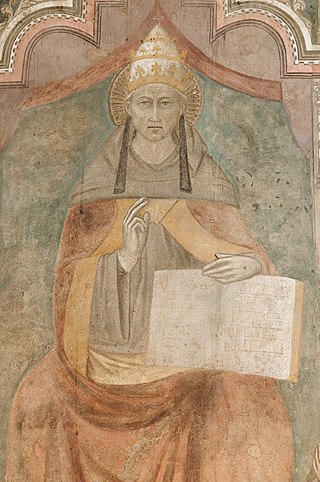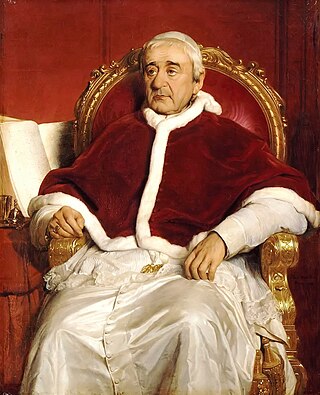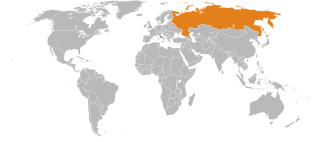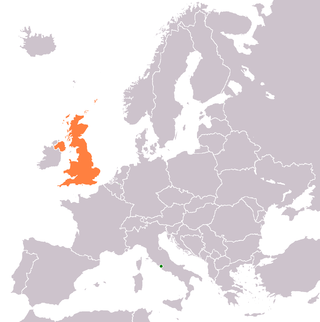
Pope Celestine V, born Pietro Angelerio, also known as Pietro da Morrone, Peter of Morrone, and Peter Celestine, was head of the Catholic Church and ruler of the Papal States for five months from 5 July to 13 December 1294, when he resigned. He was also a monk and hermit who founded the order of the Celestines as a branch of the Benedictine order.
Pope Gregory V, born Bruno of Carinthia, was the bishop of Rome and ruler of the Papal States from 3 May 996 to his death. A member of the Salian dynasty, he was made pope by his cousin, Emperor Otto III.

Pope Gregory XVI was head of the Catholic Church and ruler of the Papal States from 2 February 1831 to his death in June 1846. He had adopted the name Mauro upon entering the religious order of the Camaldolese.

Doctor of the Church, also referred to as Doctor of the Universal Church, is a title given by the Catholic Church to saints recognized as having made a significant contribution to theology or doctrine through their research, study, or writing.
John XVI was an antipope from 997 to 998.

A papal conclave is a gathering of the College of Cardinals convened to elect a bishop of Rome, also known as the pope. Catholics consider the pope to be the apostolic successor of Saint Peter and the earthly head of the Catholic Church.
A papal renunciation also called a papal abdication, occurs when the current pope of the Catholic Church voluntarily resigns his position. As a pope's time in office has conventionally lasted from his election until his death, a papal renunciation is an uncommon event. Before the 21st century, only five popes unambiguously resigned with historical certainty, all between the 10th and 15th centuries. Additionally, there are disputed claims of four popes having resigned, dating from the 3rd to the 11th centuries; a fifth disputed case may have involved an antipope.

The Order of Pope Pius IX, also referred as the Pian Order, is a papal order of knighthood originally founded by Pope Pius IV in 1560. Currently, it is the highest honor conferred by the Holy See. The awarding of the order fell into disuse and was re-instituted by Pope Pius IX as a continuation on 17 June 1847.
The Secretariate of Briefs to Princes and of Latin Letters, or simply the Secretariate of Briefs, was one of the offices of the Roman Curia abrogated in 1967 during Pope Paul VI's reform of the Pontifical court. It was divided into two sections.

Fernando Filoni is an Italian cardinal of the Roman Catholic Church who serves as Grand Master of the Equestrian Order of the Holy Sepulchre. He was Prefect of the Congregation for the Evangelization of Peoples from 2011 to 2019. He is an expert in Chinese affairs and on the Middle East.

Camillo di Pietro was an Papalini Catholic prelate who served as Camerlengo of the Sacred College of Cardinals and later Camerlengo of the Holy Roman Church. He was elevated to the cardinalate in 1853.

Giuseppe Bertello is an Italian prelate of the Catholic Church, a cardinal since 2012, who was President of the Pontifical Commission for Vatican City State and President of the Governorate of Vatican City State from October 2011 to October 2021. He worked in the diplomatic service of the Holy See from 1971 to 2011; became an archbishop in 1987; held appointments as Nuncio to several countries, including Rwanda, Mexico, and Italy; and was the Holy See's representative to a number of international organizations.

Holy See–Russia relations are the bilateral relations between the Holy See and Russia. The Holy See has an Apostolic Nunciature in Moscow. Russia has a permanent representative to the Holy See based in Rome.

Holy See–United Kingdom relations are foreign relations between the Holy See and the United Kingdom.
Quo graviora, or On the Pragmatic Constitution, was the name of a letter ("breve") issued by Pope Gregory XVI on 4 October 1833. It was addressed to the bishops of the Upper Rhineland concerning the movement for reforms in the ecclesiastical province of the Rhineland at that time.
The orders, decorations, and medals of the Holy See include titles, chivalric orders, distinctions and medals honoured by the Holy See, with the Pope as the fount of honour, for deeds and merits of their recipients to the benefit of the Holy See, the Catholic Church, or their respective communities, societies, nations and the world at large.

The resignation of Pope Benedict XVI took effect on 28 February 2013 at 20:00 CET, following his announcement of it on 11 February. It made him the first pope to relinquish the office since Gregory XII was forced to resign in 1415 to end the Western Schism, and the first pope to voluntarily resign since Celestine V in 1294.

Bosnia and Herzegovina and the Holy See have maintained diplomatic relations since the former declared independence in 1992. The two states have signed a concordat, and there have been three papal visits to the multiconfessional Bosnia and Herzegovina. The relations with the Holy See have generally been fostered primarily by the Bosnian Croat and Bosniak officials, but sometimes aggravated by Bosnian Serb officials.

Rothschild loans to the Holy See refers to a series of major financial loans arranged between the Rothschild family and the Holy See of the Catholic Church. The first loan which occurred in 1832 took place in the aftermath of the Napoleonic Wars during the Pontificate of Pope Gregory XVI. This loan agreed on was for a sum of £400,000. A second loan occurred during the Pontificate of Pope Pius IX in the early 1850s with the same members of the Rothschild family after the collapse of Giuseppe Mazzini's short-lived revolutionary Roman Republic and the restoration of the Papal States.
The COVID-19 pandemic in Vatican City was a part of the worldwide pandemic of coronavirus disease 2019 caused by severe acute respiratory syndrome coronavirus 2. The Holy See reported the first case of infection in Vatican City on 7 March 2020. Unlike other jurisdictions that report cases within a given territory or cases of residents or citizens of a territory, the Holy See reports on cases "in Vatican City State and among the employees of the Holy See" regardless of location of testing, treatment, or residence. There were 29 confirmed cases of COVID-19 among the Vatican's residents and employees; there were no associated deaths. The 29 cases included 10 employees, 1 new hire, and 1 resident of Vatican City. All those infected tested negative by 6 June 2020. An outbreak among members of the Holy See's Swiss Guard was reported in mid-October, totaling 11 as of October 15.











